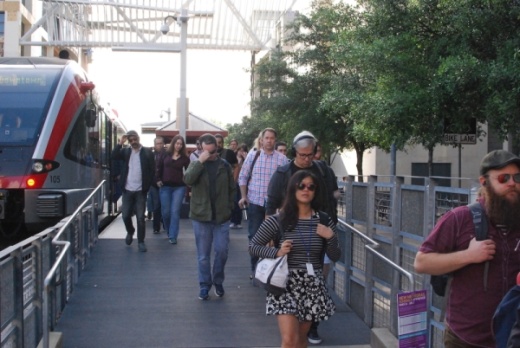High-capacity transit is a transit option that carries large amounts of people through the city with greater frequency than a typical bus schedule, according to experts. Generally, there is community consensus around the need for high-capacity transit in Austin; San Antonio is the only other city among the country’s 11 most populated without high-capacity transit options. Yet the choice between which vehicles should move people—buses or rail cars—has remained a point of regular debate. Numbers presented this week show a bus system costing $3.2 billion and a rail system costing up to $10.3 billion.
For some officials, the needle on that debate moved during Jan. 14’s public unveiling of the transit proposals, as transportation experts from the city and its transit authority, Capital Metro, said a high-capacity transit system focused on buses would become obsolete by 2040 due to a bus system’s limited ability to add cars and keep up with expected population growth.
“So [if we chose bus] billions would have been spent, and in 20 years we won’t even be able to use the system we built because we can’t fit more into it, that’s the problem with bus,” District 6 City Council Member Jimmy Flannigan said. “So, we’re talking about rail. And I find that kind of exhilarating but also nerve-wracking. That’s a big question.”
Flannigan went further. Within the rail proposal there is also a choice to build a 1.6-mile downtown tunnel that could connect the two rail lines. Capital Metro Program Director Dave Couch told officials yesterday the tunnel would yield greater capacity because it allows transit vehicles to avoid traffic and decrease its total travel time, which in turn allows the system to make more trips throughout the day.
Couch also pointed out that the downtown tunnel would also allow the transit system to circumvent the limits posed by the city’s condensed street grid. For surface-level rail, downtown’s street grid would only allow up to three rail cars per train—anything larger would block up intersections during rail stops and create further gridlock.
“We’re talking about rail in a tunnel,” Flannigan said. “That’s a subway. I mean, wow. That’s what real cities do. So ... we can go small and fail, because it will be full 10 years after [the system] is built, or, we can make the right investment for the future of our city. And that seems to be the choice that’s in front of us.”
Mayor Steve Adler said the way conversations were going a year ago, he imagined he would end up supporting a bus system because of the cost; however, he said he is no longer comfortable pursuing a major transit investment system focused on buses.
“It just makes sense that we shouldn’t be investing billions of dollars in something that we’re going to want to be retrofitting five years after we’ve completed it,” Adler said. “I know it’s more expensive to do rail. I think we need to spend the money so we’re not making a decision that’s good for the next couple decades, but one that’s good for the next couple generations.”
Capital Metro CEO Randy Clarke emphasized that a light rail with a downtown tunnel would strengthen the entire transit system. He said even if the light rail routes do not touch corridors such as Martin Luther King Jr. or South Lamar boulevards, service and frequency would increase for those bus services as a tunnel system would alleviate high-capacity transit’s effect on downtown and traffic for any bus routes that touch the area.
“We have to have the downtown core built correctly for multiple generations because it impacts everything around the network,” Clarke said.
District 5 Council Member Ann Kitchen told Community Impact Newspaper she remains on the fence about the options but said during the meeting that the city needs to go big.
“It’s past time to transform the system; we have to do something big; we have to do something that works for the whole community,” Kitchen said.





